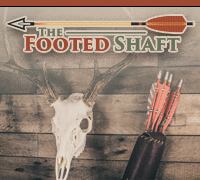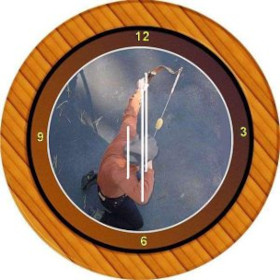This is from the "History of Archery" by Tom Brissee, lots of technical historian detail going back before 25,000BC w/ the only mention of official sight use beginning in 1937. Interesting read nonetheless:
"The oldest arrow heads were discovered in Africa and were dated to be from before 25,000 BC. Scientists have theorized that the bow was created as an off-shoot of the spear-thrower. Somewhere around 25,000-18,000 BC, man began to use fire to further harden his stone arrowheads and added feathers to his arrows in order to improve accuracy. In Italy, a skeleton was found in a burial tomb with a fragment of a flint arrowhead lodged in it's pelvis. It was dated to from around 11,000 BC. Arrow shafts are found in Germany and were dated to be from 9,000 BC. Bows found in Denmark are dated to be from 8,000-6,000 BC. They were made from one piece of Yew or Elm. Drawings from 7500 to 5,000 BC show that the Egyptians used bows for hunting and warfare. In 1991, the body of a 45-yr. old man was discovered on the present-day border between Italy and Austria and dated to be from 3,300 BC. He was dressed in a leather clothe, a waterproof cloak made of grasses and carried a framed backpack, a utility belt with tools, a quiver of 14 arrows, a knife made from flint and a copper axe. The axe caused much interest as it's age pre-dated the previous estimations of the development of smelting copper by 1000 years. His wooden arrows had flint arrowheads and the quiver included a flap to keep the feathers dry. His body and hair tissues were analyzed and found to contain high amounts of copper and arsenic, by-products of smelting copper ore. He carried arrows of two lengths and it was estimated that he may have traded one of his copper axes for some arrows during his travels.
In approx. 2800 BC, the first composite bow was produced by the Egyptians. It was made from wood, tipped with animal horn and held together with animal sinew and glue. Unstrung, it resembled a "C" shape and would have required 2 people to string it. The bowstring was made from "catgut" (sheep intestines). The arrows used were extremely light, could be shot 400 yards using the composite bow and would easily penetrate the armor of that time period. The Egyptians used archers on the back of light chariots who were highly trained and skilled and could easily outflank an enemy army with devastating effect. Literature from China, dated between 1500 and 1027 BC, included the first mention of Crossbows. Chinese nobles attended special schools, where they were taught archery, music, rituals, charioteering, mathematics and writing, between 1200 and 700 BC. In 250 BC, the Parthians (from what is now Iran and Afghanistan) would battle with bows from horseback. They developed a technique of pretending to flee, while firing arrows back towards the enemy. This could be where the phrase "a Parthian shot" became today's phrase "a parting shot". The First Emperor of China, Qin Shihuang, was buried in a burial pit in 221 BC. This burial pit included 6000 life-size terracotta figures, many of which carried crossbows. Sebastian, the commander of a company of Preatorian Guards for the Roman Emperor, Diocletian, was ordered to be bound to a stake and shot to death with arrows when his belief in Christianity was discovered in 288 AD and he refused to renounce his faith. After the deed was done, he was found by a friend to still be alive and was nursed back to health. Later, he proclaimed his faith from the steps of the Emperor's palace and the guards were ordered to beat him to death with clubs and throw his body in the sewer. His body was recovered by friends and buried in the catacombs under the city of Rome. Sebastian came to be known as the Patron Saint of Archers.
Arrowhead evolved to include the following:
Barbed arrowheads-these would make arrow removal difficult.
Small Triangular tips-used to pierce chain-mail armour.
Half-moot tips-used to cut through the rigging of opposing ships.
In 1208 AD, Temujin became Great Khan of the Mongols, better known as Genghis Khan. The Mongols used composite bows of approx. 70lb. Draw weight and used a thumb ring to release the bowstring. Unarmored Mongol soldiers would were silk under-shirts to minimize injuries inflicted by the arrows of the enemies. The silk fabric would wrap around the arrow head without being cut as the arrow stuck the Mongol soldiers. This would allow the clean removal of the arrows by slowly pulling on the silk fabric, eliminating further damage caused by the barbed arrowheads.
1307 AD--William Tell-William refused to bow towards a hat placed on a pole as a sign of imperial power and was ordered to shoot an apple off of his son's head. (He was known as an expert crossbowman.) He succeeded in shooting the apple, leaving his son untouched. It was also said that he had another crossbow bolt hidden and, if he had failed to shoot the apple and had killed his own son, he would have quickly reloaded in order to kill the official who had ordered him to shoot the apple off of his son's head.
1346 AD-The French army included crossbow men. Their crossbows were fitted with cranks used to draw back the bowstrings. During the Battle of Crecy, Edward III of England lead his army against the French. The French were defeated when the previous day's rain weakened their bowstrings which misfired or snapped completely during battle. The English had kept their bowstrings dry by putting them under their helmets during the rain.
Both crossbows and standard hand-shot bows were used as the most effective battle weapons, until the late 1500's, throughout what is modern day Europe and Asia. In 1520 AD, the musket was invented. In 1545, Roger Ascham wrote the first book written in the English language about archery, called "Toxophilis"(Lover of the Bow). In 1588 AD, 10,000 soldiers from the English fleet, armed with muskets, defeated the Spanish Armada. The last battle in which English archers were used was 1644 AD. During the latter half of the 1600's, contests of archery skill came into vogue in England.
In 1872, Ephraim Morton of Plymouth, Massachusetts, USA is granted a patent for his wood handled bow with steel rod limbs. Archery was included in the Olympic Games in 1904, 1908 and 1920. It was discontinued until it reappeared at the 1972 Olympics.
1934-Year of the first Bow hunting season in the United States, held in the state of Wisconsin.
1937-First use of bow-sights in archery competition.
1939-James Easton experiments with making arrow shafts out of aluminum, rather than wood.
1941-Larry Hughes uses aluminum arrows to win the American National (archery) Championship.
1942-Hoyt Archery co. founded by Earl Hoyt, Jr.
1946-Easton produces it's first trademarked aluminum arrows, the "24 SRT-X".
1951-Max Hamilton introduces "Plastiflech" vanes to replace feathers.
1953-Bear Archery develops and sells the first working recurve bows. Previous bows were straight-limbed longbows.
1956-Hoyt Archery develops the first "Pistol grip" bow handle.
1958-Easton develops the "XX75" aluminum arrow shaft.
1961-Hoyt Archery introduces the "Torque stabilizer".
1966-Easton develops the "X7" aluminum arrow shaft.
1969-Holless Wilber Allen is granted a patent on his invention of the Compound Bow which he designed 3 or 4 years earlier. His original wheels were triangular in shape.
1970-Compound bows and release aids make their national debut in U.S. national archery competition.
1971-Andy Rimo develops the "flipper" rest. Pete Shepley starts PSE archery company. Flex Fletch manufactures it's first soft plastic arrow vanes.
1974-Freddie Troncoso invents the first dual-prong arrow rest.
1982-Cam wheels on compound bows first appear. Previous wheels where perfectly round.
1983-Easton develops the first carbon arrow shaft.
1992-The Olympic torch, in Barcellona, Spain is ignited using a flaming arrow shot by Antonio Rebollo of the Spanish Olympic Team. Matt McPherson founds Matthews Archery Co., manufacturing bows with single-cam technology.
1995-The Compound Bow is included in the World Target Archery Championship competition for the first time."
Daddy Bear














